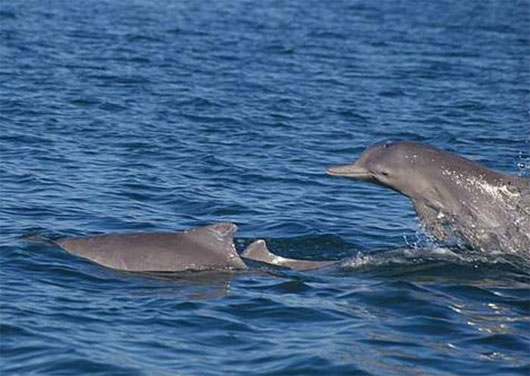Discover new humpback dolphins near Australia
(An unprecedented humpback dolphin species discovered in northern Australia, according to a team of scientists working for the conservation of Wildlife Conservation Society, the museum The American Museum of Natural History and many other groups of agencies involved in the study said.
To determine the number of extinct dolphins belonging to the humpback dolphins (named fish humpback dolphins because it has a very specific hump just below the dorsal fin), the team studied history. evolution of this oceanic mammal, using both morphological and genetic data. While Atlantic Ocean dolphins are a recognized species, this study is the best proof to determine when the Indian-Pacific humpback has been split into 3 species, one of the It is completely new to science.
'Based on research results and genetic analysis combined with morphological analysis, we can assume that humpback dolphins consist of at least 4 species'. Dr. Martin Mendez, assistant director of WCS's Latin America and Caribbean Program and the lead author of the study, said. 'This discovery helps clarify the understanding of the evolutionary history of this group of organisms and inform conservation policy makers to support the protection of each species' safety.

The authors claim that, at least 4 species in the humpback dolphin family are: Atlantic humpback dolphin ( Sousa teuszii ), a species that appears in the Southern Atlantic Ocean of the West Africa; Indian-Pacific humpback dolphin ( Sousa plumbea ), a species distributed from the central region to the South of the Indian Ocean; and another species of Indian-Pacific humpback dolphin ( Sousa chinensis ), residing in the South Indian Ocean and Western Pacific, and the fourth Sousa species found in the North. Australia has yet to be named (the formal adjustment of names and species appears through a separate and complementary process based on these research results).
'New information on extinct species through humpback pigs will increase the number of identified species, and provide the scientific evidence necessary to identify management for the purpose of protecting the diversity. Their genetic patterns and important habitats are involved, 'said Dr. Howard Rosenbaum, director of WCS's Ocean Giants Program and author on the paper.
The study to clarify the classification for a lesser-known broad distribution of dolphins, the authors collected a large set of data on physical characteristics collected mostly from dolphins aground and Museum specimens. In particular, the team examined the characteristics of the 180 skulls that collected most of the distribution area of the humpback dolphin to compare morphological features through this area.
The researchers also took 235 tissue samples from the same animals in the region stretching from the Eastern Atlantic Ocean to the Western Pacific Ocean, analyzing both mitochondrial DNA and human DNA for notable variations. in populations.
Adult humpback dolphins are about 8 feets long and colored from black to pink or white. This species usually lives in coastal waters, deltas, estuaries and occurs from the Indian and Pacific waters to the Australian waters. Atlantic humpback pigs are thought to be 'Vulnerable ' according to the IUCN Red List, but Sousa chinensis, the Indian - Pacific dolphin, is listed as a species. 'Nearly threatened - Near Threatened'.
- The upturned nose dolphin smiles on the sea
- Humpback dolphins have human-like brain cells
- Discovering an extremely rare albino humpback whale
- Rare white whales appear in Australia
- Thousands of dolphins appear along the coast of South Africa
- Australia found new dolphins in the Melbourne region
- The 20 ton humpback humpback whale stands on the sea surface
- The rarest animal on the planet suddenly appeared
- Australia worries that rare dolphin species disappear
- See the amazing performance of humpback whales
- Video: Rescue the lumpy humpback whale
- Why are humpback whales disappearing in Hawaii?
 Surprised: Fish that live in the dark ocean still see colors
Surprised: Fish that live in the dark ocean still see colors Japan suddenly caught the creature that caused the earthquake in the legend
Japan suddenly caught the creature that caused the earthquake in the legend A series of gray whale carcasses washed ashore on California's coast
A series of gray whale carcasses washed ashore on California's coast Compare the size of shark species in the world
Compare the size of shark species in the world